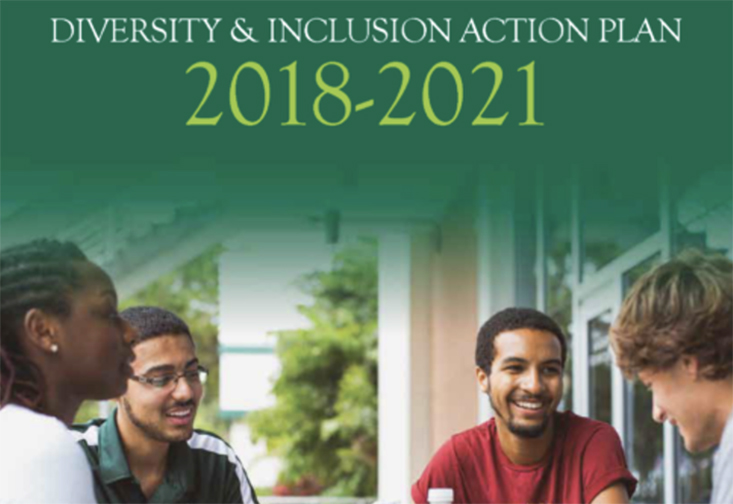The university’s first Diversity and Inclusion Action Plan seeks to create synergy and collaboration with every individual in the campus community through unique initiatives and study circles to inspire and ensure a welcoming environment.
“No matter if the person is a transgender individual, a person of color, a veteran, you name it, our vision is to make sure that everyone is accepted and respected without any limitations,” Cecil Howard said, Chief Diversity Officer. “It is our job to appreciate each person in our campus community.”
Howard was hired by the university in November 2016. In a matter of a few short months, he had assembled a 21-member planning committee comprised of faculty, staff and two students throughout the university community to provide input and help generate the key initiatives and goals of the university-wide plan. The final plan was approved by the USF St. Petersburg Campus Board on February 1, 2018, with six main goals:
- Clearly define, publicize and implement the University’s commitment to diversity and inclusion;
- Develop annual reports summarizing progress in both internal processes and key outcomes toward advancing diversity and inclusion goals;
- Create a welcoming environment for all individuals regardless of race, gender identity, age, types of ability, sex, sexual orientation, faith, nationality, ethnicity, socio-economic background, job role and function, culture, viewpoints and familial status;
- Recruit, retain and promote more women and individuals from underrepresented backgrounds in faculty, staff and administrator level positions;
- Recruit, retain, develop and graduate more diverse undergraduate and graduate students to support equitable representation; and
- Provide high quality diversity education, orientation and training for all members of the university community.
Howard noted that before the approval of the Diversity and Inclusion Action Plan, there were already efforts and endeavors underway with various departments, offices and groups on campus to cultivate a more diverse and inclusive community. The plan was created to bring a more comprehensive effort to what was already in place, as well as guide what else needs to be done to create a fully diverse and inclusive campus culture.
“This is a good roadmap and we all have to work together,” Howard said. “Nothing in the plan designates accountability of one particular person or department, division, unit, etc. Everyone’s efforts will work together to help push a total university wide effort.”
Since its approval, Howard and the plan’s committee have been hard at work implementing and tackling the multitude of initiatives under each of the six strategic goals.
To help incorporate initiatives from the plan into daily campus life, Howard hopes to assign small sub-groups of three people to conduct research, disseminate surveys, determine what other universities are doing and report back with recommendations on how a particular initiative should be carried out.
Study Circles will also inform the plan and its progress. These small groups of eight to twelve volunteers meet every Tuesday for six weeks. The importance of these Study Circles is to create the opportunity for dialogue and to hear everyone’s views and perspectives.
“This group provides complete anonymity, so that we can openly discuss difficult and challenging topics and issues,” Howard said.
The first Study Circle successfully completed their six weeks of meetings and included 11 people from the campus community. Staff, students, faculty and one community member volunteered to be part of the group and represented Black, Hispanic and Caucasian individuals, various faiths, male and female and a wide range of ages. Now, the team will meet on its own to finalize the action item they intend to present to the University Cabinet.
“The beauty of Study Circles is it brings a diverse group of people together to help dismantle racism or other forms of bias, based on their own life experiences as well as their experiences with each other,” Howard said.
At the beginning of every fall term, Howard will provide a progress report to the campus board and community. It is considered a living document and will be updated with findings through research and data collection from sub-groups, Study Circles and other initiatives that are implemented from the plan.
“We want to make sure we are adequately communicating our commitment to diversity and inclusion, making students, staff and faculty feel welcome, comfortable, respected and appreciated,” Howard said.
To learn more about the Diversity and Inclusion Action Plan, to get involved in a future Study Circle or sub-group or offer ideas to promote diversity on campus, please contact Charlene Ponce via email: ponce@mail.usf.edu or office phone: 727-873-4387.
